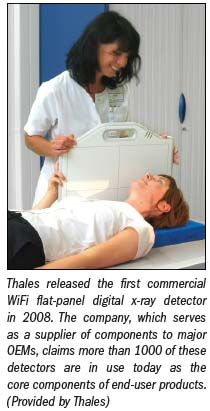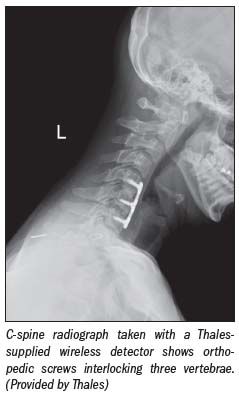Portable DR detectors threaten to elbow CR from center stage
Wireless detectors are taking point position in radiology’s effort to turn analog radiography into digital radiography.
Wireless detectors are taking point position in radiology’s effort to turn analog radiography into digital radiography. Their wired predecessors laid the groundwork, finding workflow advantages over computed radiography. Now, free of the cables that constrained their use, battery-powered wireless versions promise to boost productivity further through ease of use and flexibility in applications.
They are part of a vast shift in technology not just in medicine, but in all kinds of electronics. From iPhones, BlackBerrys, and Droids to cable-free PC printers, the world has gone wireless.

For radiology, they can be a game changer. The untethered digital panel, with its transmitter and battery, trumps both CR and conventional DR. It combines the principal advantages of CR-turning analog units into digital ones that, like CR plates, can be easily positioned and used for table and upright buckys-while avoiding the time delay of having to walk CR plates to and feed them into a reader.
This is the most obvious application: when it’s installed instead of, or in place of, CR to upgrade analog radiography systems. Alternatively, these panels can be embedded in brand new radiography suites or retrofitted into portable x-ray units. Portable detectors built into mobile x-ray systems take DR to the patient bedside and into the emergency department, the operating room, and the ICU.
Memorial Medical Center, a teaching hospital Level One trauma center and regional burn center with about 500 beds in Springfield, IL, has been using wireless DR since last November. It now has wireless panels in four of its emergency rooms, in a general radiography suite, an outpatient facility, and onboard portable units used throughout the hospitals and occasionally in the operating room. More are on order for use in the OR, but the surgeons, according to Marjorie Calvetti, medical imaging director at Memorial Medical Center, are getting antsy.
“We tell them they are budgeted and they’re coming,” Calvetti said. “But they keep asking.”
Carestream Health has popularized the wireless technology with a high-profile, multipronged campaign begun a year ago. Its DRX-1 detector was first sold to upgrade installed stationary and mobile systems to digital, and more recently as an integral part of Carestream’s turnkey Evolution radiography suite.
Canon entered the wireless market segment in late summer with the unveiling of its CXDI-70C Wireless Digital Radiography System at the American Healthcare Radiology Administrators meeting. The company, previously an advocate of wired portable detectors as the way to go from analog to digital, described its latest commercial product as offering more portability to medical practitioners.
NOT YET DOWN FOR THE COUNT
But it’s too early to write off wired detectors altogether. Canon contends they have a place in the digital radiography marketplace and Fujifilm agrees. With much fanfare, Fuji released in July its D-EVO (digital evolution) wired portable detector. The six-pound panel is lighter by more than a pound than its untethered competitors.
And there is a cost advantage to the purchase of wired portable detectors for budget-challenged customers, an advantage acknowledged by vendors who offer both types of detectors. Thales is promoting the wired version of its portable Pixium as mobile, robust, and less expensive than the wireless version.
SOLID-STATE = SPEED
Both wired and wireless portable detectors are faster than CR by virtue of their solid-state technology, which delivers images in seconds rather than the minutes needed to transport, feed, and read CR plates. These detectors also hold the potential for lower dose exposures and better image quality.
Although medical physicists point out that any digital medium holds the potential to enhance images and, therefore, can be leveraged to cut dose, CR has been associated with dose creep, the tendency by users to apply higher doses to get crisper pictures. Heartland Regional Medical Center in St. Joseph, MO, has cut patient radiation dose in half since switching to portable DR detectors, according to Larry Kirschner, radiology team leader at Heartland Regional.

Centers using wireless DR detectors typically cite productivity and efficiency as the driving forces behind their choice. Heartland Regional is among them. But wired detectors also promise improved productivity. Tethers, though cumbersome, can be stretched to wherever the detector needs to be. And makers of these products argue that transmission speeds are faster over cable than with a wireless connection.
The argument for wireless gains ground, however, when such detectors are used in a busy emergency department, as tethers can get in the way of staff. In operating or interventional suites, they raise concerns about sterility.
“Not having a cord is a big benefit to us,” Kirschner said. “The techs don’t have to unplug and plug in the plate, and we don’t have to worry about keeping them sterile.”
Community-based Memorial Hospital in York, PA, chose wireless rather than wired systems, but for a less detailed reason. The hospital has made a conscious decision to adopt leading-edge technology. It operates a fixed MRI and two SPECT/CTs. In late summer, the 100-bed hospital took delivery of a da Vinci surgical robot.
“We did look at nonwireless digital solutions and we did a couple of site visits. But once we saw the wireless, we knew that’s what we wanted,” said Robin Wible, director of imaging at Memorial Hospital.
Similarly, Springfield’s Memorial Medical Center chose wireless as part of a broad-based strategy to take the entire hospital wireless over the next five years.
“For us to be able, in the next five years, to be completely wireless and be at the patient’s bedside and in the emergency department and able to work very quickly is definitely on our radar,” Calvetti said.
Because portable DR detectors and their accompanying consoles and retrofit kits are more expensive than CR, the cost of their purchase typically needs to be justified by substantial procedure volumes.
Mayo Clinic evaluated wireless DR in its surgical suites in place of CR and also in the emergency department. The six minutes needed to carry CR plates to a reader, then feed and scan the plates is now just seconds with DR in the emergency department suite. Besides better and faster patient care, time savings translate into cost savings, as costs in the operating room are measured in OR minutes. The ORs experienced an average 10 to 15 minutes quicker turnaround times.
TIME IS MONEY
In the grander scheme, those saved minutes turn into expense savings and revenue production, according to Bonnie Standley, former director of radiology at the Mayo Clinic in Rochester, MN. The time saved per day allows the surgeons to add more cases without having to expand the facility, said Standley, who this fall left Mayo and joined the Carle Foundation in Urbana, IL, as vice president of diagnostic services.
“The faster you can get the patient out of anesthesia, the quicker you can turn around the OR rooms,” she said.
With a 45-room emergency department serving a 21-county area of northwest Missouri, northeast Kansas, and southeast Nebraska, Heartland Regional Medical Center has accumulated some significant savings with wireless DR as a replacement for CR. But it’s not money saved so much as it is time.
“The trauma surgeons and ER docs are thrilled to death to be able to see an image on the monitor in four seconds,” Kirschner said.
Trauma surgeons at Heartland Regional use portable DR as a quality check on the fundamentals, like getting the count right on sponges and clamps before closing a patient. Staff at Memorial Hospital in York, PA, use portable DR to check line placements.
These portable panels are replacing technology that is decades old in design. As CR aged, digital detectors matured. Fabrication of solid-state detectors became more efficient, designs more robust. In 2005, GE Healthcare unveiled its Definium AMX 700, a mobile x-ray system built around a flat-panel detector. The introduction signified that solid-state detectors were able to handle the bangs and dings that come with cornering in hospital hallways and getting onto and off of elevators.
With their acceptance in this, the most physically challenging area of radiography, the conversion to DR was complete. The flat panels that started the transition to digital had become ubiquitous, built into fixed x-ray systems. And the lightweight and sturdy panels needed for mobile x-ray units had found complementary uses in fixed radiography suites, where they could be slipped under patients and to their sides to make lateral exposures.

Wired and wireless detectors were logical next steps. Detector manufacturers Thales, Canon, and Varian led the way, supplying detectors as part of their own retrofits or for use in end-user products made by major manufacturers. Siemens Healthcare featured at RSNA 2007 a wireless detector built into its Ysio general radiography system. Shown as a work-in-progress, Ysio began shipping to U.S. customers in 2008. It can be configured with one or two detectors for table and wall stand. A key feature is fully automated and synchronized movements that can be programmed into some 500 discrete positions, according to the company.
Philips’ Eleva Wireless was shown as a work-in-progress in 2008. It has since become commercially available in the U.S. It is an integral part of the company’s DigitalDiagnost radiography rooms, but can be configured for use in ICU, trauma, or the operating room, according to Philips.
Carestream last year caught the wireless DR wave with its DRX-1. Along with its console, the detector upgrades stationary radiography suites to digital. With the mobile retrofit kit, it transforms mobile x-ray systems from GE, Siemens, and Shimadzu. It is also part of the Carestream DRX-Evolution, a turnkey radiography suite featuring two wireless detectors. These detectors, as well as those built into stationary retrofit suites, can be shared with mobile x-ray systems that have been upgraded with mobile retrofit kits.
Last summer the company released an enhanced version of the wireless portable, the DRX-1C, which uses a cesium iodide scintillator to deliver higher detective quantum efficiency (DQE) and, therefore, improved image quality. It uses the same battery and electronics as the DRX-1 and can be applied in the same settings. It is designed to be used with all three DRX-based imaging solutions.
The field of companies vying for this market is getting crowded. Canon’s CXDI-70C Wireless DR System is ready for the U.S. market, having received FDA clearance earlier this year. Other vendors include DICOM Solutions with its 8.3-pound wireless detector, called Genesis Neo DR, and Viztek with a 10-pound wireless version. Another is iMix, which is developing a flat-panel wireless detector as part of a portfolio of DR products.
COMPLICATING DECISIONS
The proliferating choices of commercial products can complicate decisions for buyers. And there are more challenges to portable DRs than just which one to buy. These systems are not always as plug-and-play as might be hoped. At the Mayo Clinic, which has a lot of homegrown data systems with different passwords, having good engineers for trouble-shooting can be very helpful.
It must also be considered, say users, that portable detectors need special handling. They look just like film cassettes or CR plates, but they are nowhere near as rugged.
“They have glass panels,” Calvetti said. “You can’t roughhouse with them and just throw them on a table. You have to treat them like you would a (laptop) computer.”
Members of the staff eventually come to respect the high-tech panels, she said, but it takes some education to get them there.
Who adopts portable DR is very much an individual decision. Several factors may be considered in making the choice. Economics is commonly among them and the deciding factor when efficiency and productivity are issues. Choosing between wired and wireless versions makes the choice more interesting.